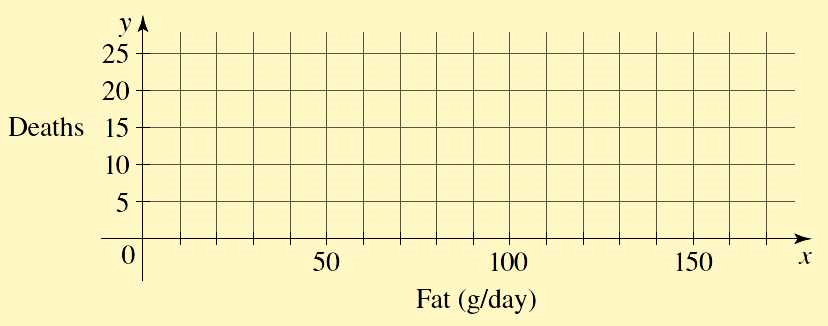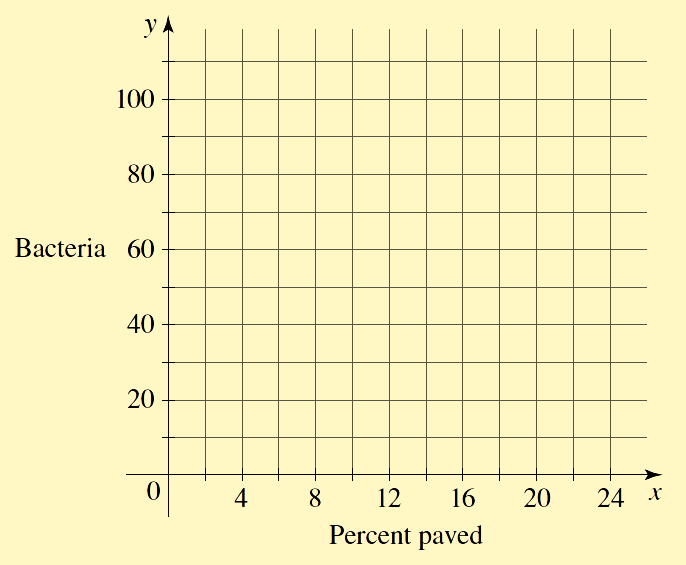DISCOVERY PROJECT
Correlation and Causation
OBJECTIVE To understand real-life examples in which two variables are mathematically correlated but changes in one variable do not necessarily cause changes in the other.
If two variables are correlated, it does not necessarily mean that a change in one variable causes a change in the other. For example, the mathematician John Allen Paulos points out that shoe size is strongly correlated to mathematics scores among school children. Does this mean that we should stretch children's feet to improve their mathematical ability? Certainly not—both shoe size and math skills increase independently with age. We refer to "age" here as the hidden variable; increasing age is the real reason that shoe size and mathematical ability increase simultaneously. Here are some more examples of the hidden variable phenomenon.
Do churches cause murder? In the 1980s several studies used census data to show that the more churches a city has, the more murders occur in the city each year. With tongue in cheek, the authors claimed to have proved that the presence of churches increases the prevalence of murders. While the data were correct, the conconclusion was obviously nonsense. What is the hidden variable here? Larger cities tend to have more of everything, including both churches and murders, so the hidden variable is population size.

More churches…
Vladislav Gurfinkel/Shutterstock.com 2009

More crime?
Jack Dagley/Shutterstock.com 2009
Do video games cause violent behavior? Some studies have shown that playing violent video games and aggressive behavior are strongly correlated. While it is certainly possible that violent video games might cause desensitization to actual aggressive behavior, could there be a hidden variable here as well? Some people are innately more violent than others, quicker to lose their temper or lash out. Perhaps these inborn tendencies cause both an interest in violent video games and a tendency toward real-life violence. More research is needed to settle these questions.
It is important not to jump to conclusions. Correlation and causation are not the same thing. Correlation is a useful tool for bringing important cause-and-effect relationships to light, but to prove causation, we must explain the mechanism by which one variable affects the other. For example, the link between smoking and lung cancer was observed as a correlation long before medical science determined how the toxins in tobacco smoke actually cause lung cancer.
I. Hidden Variables
- A public health student gathers data on bottled water use in her state. Her data indicate that households that use bottled water have healthier children than households that don't. She concludes that drinking bottled water instead of tap water helps to prevent childhood diseases. Do you think her conclusion is valid, or is there likely to be a hidden variable that accounts for this correlation? Write a short paragraph to explain your reasoning.
- The residents of a seaside town have noticed that on days when the local ice cream parlor is busy, a lot of people go swimming in the ocean. They wonder whether going swimming causes people to crave ice cream or whether eating ice cream makes people want to go swimming. Which alternative is correct? Or does a hidden variable cause both phenomena? Explain your answer.
- A study investigating the connection between dietary fat and cancer in various countries came up with the data shown in the table, relating daily fat intake (in grams) and annual cancer death rates (in deaths per $100,000$ population).
Country Fat (g/day) Cancer deaths Austria $120$ $18$ Denmark $160$ $23$ El Salvador $40$ $1$ Greece $95$ $7$ Hungary $105$ $14$ Norway $130$ $17$ Poland $92$ $10$ Portugal $74$ $13$ United States $150$ $20$ - Make a scatter plot of the data. Do they appear to be linearly correlated?
- Does it seem reasonable to conclude that a high-fat diet causes cancer? What else would you need to know to settle the question?
- In the $35$ years since the study was conducted, no widely accepted mechanism has been discovered to explain how eating fat would cause cancer. Can you think of any hidden variable that would account for this correlation?

- A researcher wants to test the hypothesis that paving over ground surfaces causes an increase in fecal bacteria in groundwater. He studies six creeks in Maryland and gathers the following data relating the percentage of each creek's watershed that is covered with pavement and the average fecal coliform bacteria count (in units/$100$ mL).
Paved Bacteria $\text{7%}$ $18$ $\text{9%}$ $22$ $\text{14%}$ $40$ $\text{18%}$ $65$ $\text{21%}$ $80$ $\text{22%}$ $92$ - Make a scatter plot of the data on the coordinate plane provided on the next page. Do the data appear to be linearly correlated?
- Can you think of any reasons why the presence of pavement might increase the bacteria count?
- Some researchers don't believe that increasing paved surface area increases fecal bacteria counts. Can you think of a hidden variable that might cause both increases?

- From your own experience or your reading, think of two variables that are correlated but for which the correlation is caused by some third hidden variable. Write a short paragraph describing the correlation and explaining how the hidden variable is the true reason for the correlation.
II. Are We Measuring the Right Thing?
Just because not every correlation is evidence of causation doesn't mean that we should be too skeptical about studies that use correlation to link two variables. But sometimes people get the direction of causation wrong; instead of concluding correctly that A causes B, they conclude wrongly that B causes A. Here are some examples of this type of thinking.
- Some diet books recommend that people who want to lose weight should not drink diet soda, because studies have shown that diet soda drinkers tend to be heavier than regular soda drinkers. Does this really mean that drinking diet soda causes weight gain? How do you explain these studies?
- Inhabitants of the New Hebrides used to believe that body lice improved their health. They correctly observed that healthy people had lice and sick people didn't. Do you think their belief was reasonable? What do you think might account for their observation? (Note that lice don't like high body temperatures.)